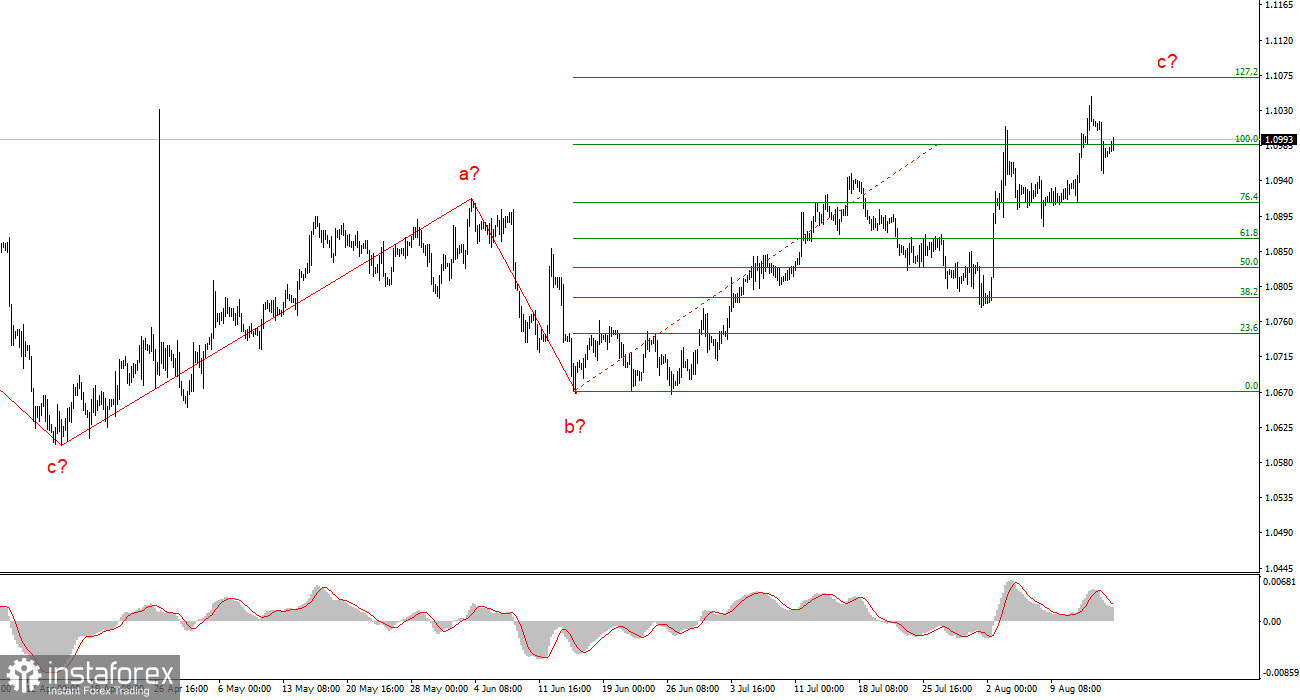
The wave pattern for the EUR/USD pair on the 4-hour chart is becoming increasingly complex. If we break down the entire trend segment that started in September 2022, when the euro dropped to 0.9530, we find that we are in the midst of an upward wave pattern. However, it's difficult to distinguish even the larger-scale waves within this segment. In other words, there is no clear impulsive trend. We observe a constant alternation of three- and five-wave corrective structures. Currently, the market has failed to form even a clear three-wave downward structure from the peak reached in July of last year. Initially, there was a downward wave that covered the lows of previous waves, followed by a deep upward wave, and now, for the seventh month in a row, we are seeing something that is hard to define.
Since January 2024, I have identified only two a-b-c three-wave structures, with a turning point on April 16. Therefore, the first thing to understand is that there is currently no trend. After the completion of the current wave c, a new three-wave downward pattern could begin. The trend segment from April 16 may take the form of a five-wave pattern, but this too would be corrective. Under such circumstances, I find it hard to believe in a prolonged rise of the euro, but it could continue for several more months.
The EUR/USD exchange rate increased by 22 basis points on Friday, but today's amplitude of movement is very weak. I cannot consider the current movement as the beginning of a new upward wave. The current picture looks more like the end of wave c. Four internal waves are clearly visible, so we might expect one last push upward to the 1.1071 level, which corresponds to the 127.2% Fibonacci level. This would be the fifth wave in c, after which a corrective wave d could begin to form. However, I should remind you that corrective structures are inherently complex, and any of them can extend further.
So far in 2024, we have only observed corrective structures. I would say that the dollar has good potential for strengthening, but it should be remembered that the news background over the last four months has regularly led to its depreciation. Therefore, if negative news from the U.S. continues to accumulate, the upward corrective structure will likely become even more complex.
Yesterday was a perfect example of what can happen in the currency market. The U.S. dollar started to gain demand after the retail sales and jobless claims reports, but its growth lasted at most an hour, as the industrial production report came out below market expectations. Today, we are set to learn the consumer sentiment index from the University of Michigan, and it is unlikely that sentiment has improved significantly over the past month.
General Conclusions
Based on the analysis of EUR/USD, I conclude that the pair continues to build a series of corrective structures. The current upward movement may continue within a five-wave corrective structure, and the scenario of forming a downward wave d has been temporarily postponed. However, this does not mean that this wave cannot start forming as soon as today. Wave c is extending further, although I did not expect the euro to rise above the 1.10 level. However, the market is unpredictable. It continues to sell the dollar under any circumstances while factoring in the expected Fed rate cuts in September, November, December, and 2025.
At a higher wave scale, it is also evident that the wave pattern is becoming more complex. We are likely to see an upward wave pattern, but its length and structure are difficult to predict at this point.
Key Principles of My Analysis:
- Wave structures should be simple and understandable. Complex structures are difficult to trade, and they often change.
- If there is no certainty about what is happening in the market, it is better not to enter it.
- There is never 100% certainty in the direction of movement. Always use protective Stop Loss orders.
- Wave analysis can be combined with other types of analysis and trading strategies.





















